Enabling E-Waste Returns: A Detailed Research Methodology Report
VerifiedAdded on 2023/06/03
|8
|1232
|141
Report
AI Summary
This report details the research methodology employed to investigate effective strategies for enabling end-users to conveniently return e-waste to manufacturers. The methodology encompasses a quantitative research design, utilizing both primary and secondary data collection methods. Primary data is gathered through surveys and face-to-face interviews with end-users and manufacturers, employing probability and non-probability sampling techniques respectively. The survey questionnaire explores user behavior and attitudes towards e-waste disposal, while interviews provide deeper insights into manufacturer perspectives on e-waste management. The report also addresses the validity and reliability of the collected data, ensuring the robustness of the research findings, and includes an appendix with the survey questionnaire used in the study. The ultimate goal is to identify actionable recommendations for improving e-waste return rates and promoting environmentally responsible practices.
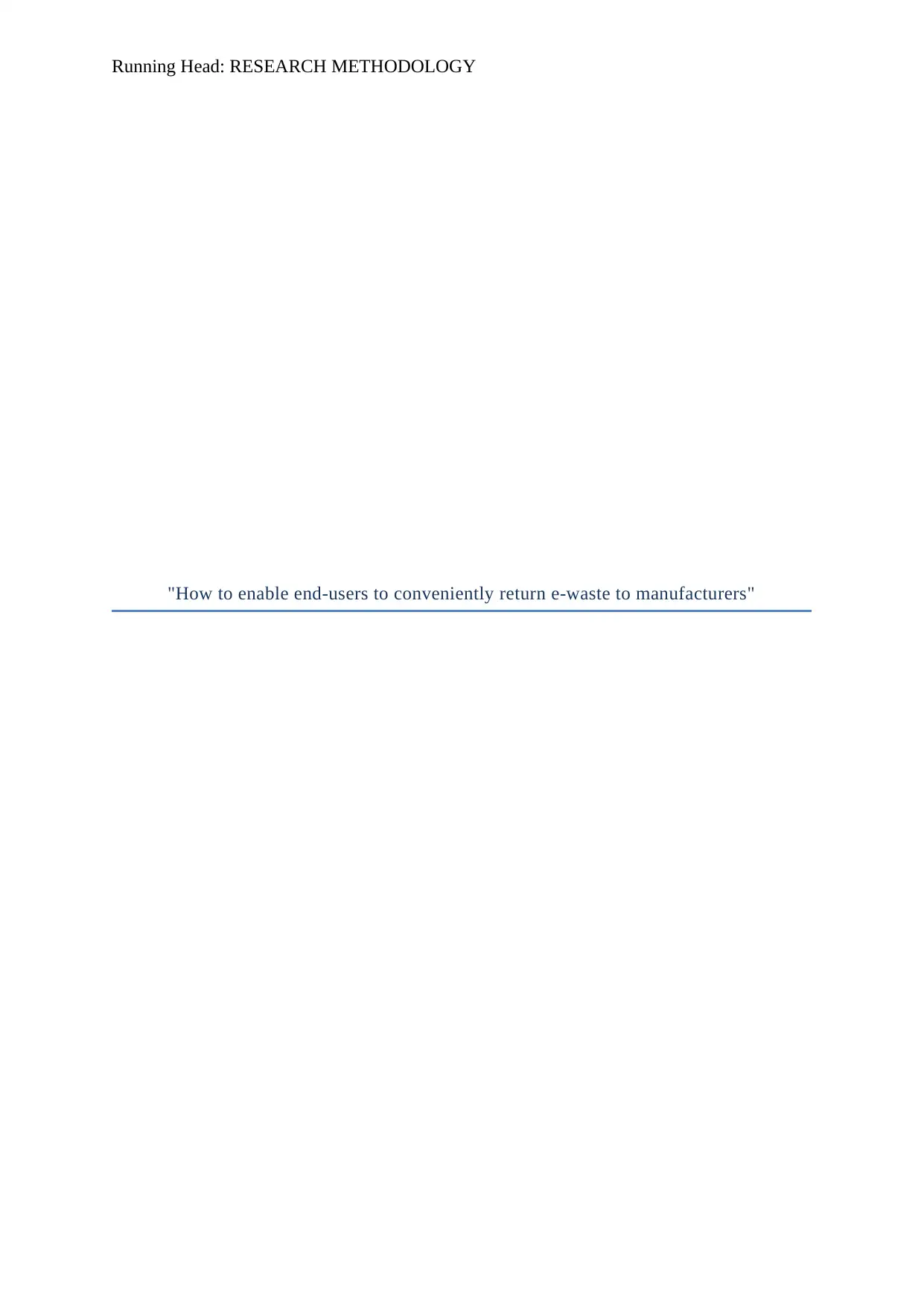
Running Head: RESEARCH METHODOLOGY
"How to enable end-users to conveniently return e-waste to manufacturers"
"How to enable end-users to conveniently return e-waste to manufacturers"
Paraphrase This Document
Need a fresh take? Get an instant paraphrase of this document with our AI Paraphraser
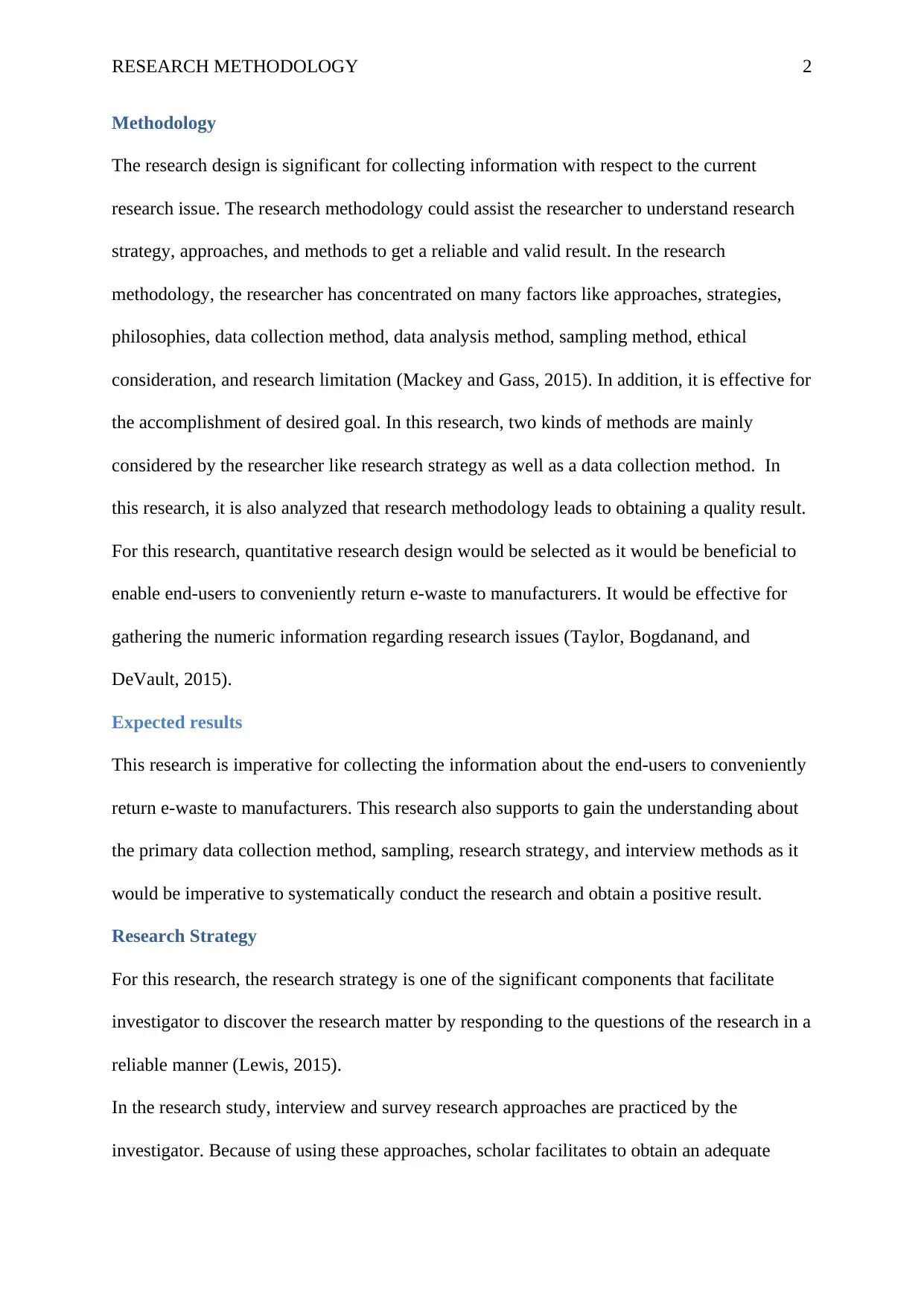
RESEARCH METHODOLOGY 2
Methodology
The research design is significant for collecting information with respect to the current
research issue. The research methodology could assist the researcher to understand research
strategy, approaches, and methods to get a reliable and valid result. In the research
methodology, the researcher has concentrated on many factors like approaches, strategies,
philosophies, data collection method, data analysis method, sampling method, ethical
consideration, and research limitation (Mackey and Gass, 2015). In addition, it is effective for
the accomplishment of desired goal. In this research, two kinds of methods are mainly
considered by the researcher like research strategy as well as a data collection method. In
this research, it is also analyzed that research methodology leads to obtaining a quality result.
For this research, quantitative research design would be selected as it would be beneficial to
enable end-users to conveniently return e-waste to manufacturers. It would be effective for
gathering the numeric information regarding research issues (Taylor, Bogdanand, and
DeVault, 2015).
Expected results
This research is imperative for collecting the information about the end-users to conveniently
return e-waste to manufacturers. This research also supports to gain the understanding about
the primary data collection method, sampling, research strategy, and interview methods as it
would be imperative to systematically conduct the research and obtain a positive result.
Research Strategy
For this research, the research strategy is one of the significant components that facilitate
investigator to discover the research matter by responding to the questions of the research in a
reliable manner (Lewis, 2015).
In the research study, interview and survey research approaches are practiced by the
investigator. Because of using these approaches, scholar facilitates to obtain an adequate
Methodology
The research design is significant for collecting information with respect to the current
research issue. The research methodology could assist the researcher to understand research
strategy, approaches, and methods to get a reliable and valid result. In the research
methodology, the researcher has concentrated on many factors like approaches, strategies,
philosophies, data collection method, data analysis method, sampling method, ethical
consideration, and research limitation (Mackey and Gass, 2015). In addition, it is effective for
the accomplishment of desired goal. In this research, two kinds of methods are mainly
considered by the researcher like research strategy as well as a data collection method. In
this research, it is also analyzed that research methodology leads to obtaining a quality result.
For this research, quantitative research design would be selected as it would be beneficial to
enable end-users to conveniently return e-waste to manufacturers. It would be effective for
gathering the numeric information regarding research issues (Taylor, Bogdanand, and
DeVault, 2015).
Expected results
This research is imperative for collecting the information about the end-users to conveniently
return e-waste to manufacturers. This research also supports to gain the understanding about
the primary data collection method, sampling, research strategy, and interview methods as it
would be imperative to systematically conduct the research and obtain a positive result.
Research Strategy
For this research, the research strategy is one of the significant components that facilitate
investigator to discover the research matter by responding to the questions of the research in a
reliable manner (Lewis, 2015).
In the research study, interview and survey research approaches are practiced by the
investigator. Because of using these approaches, scholar facilitates to obtain an adequate
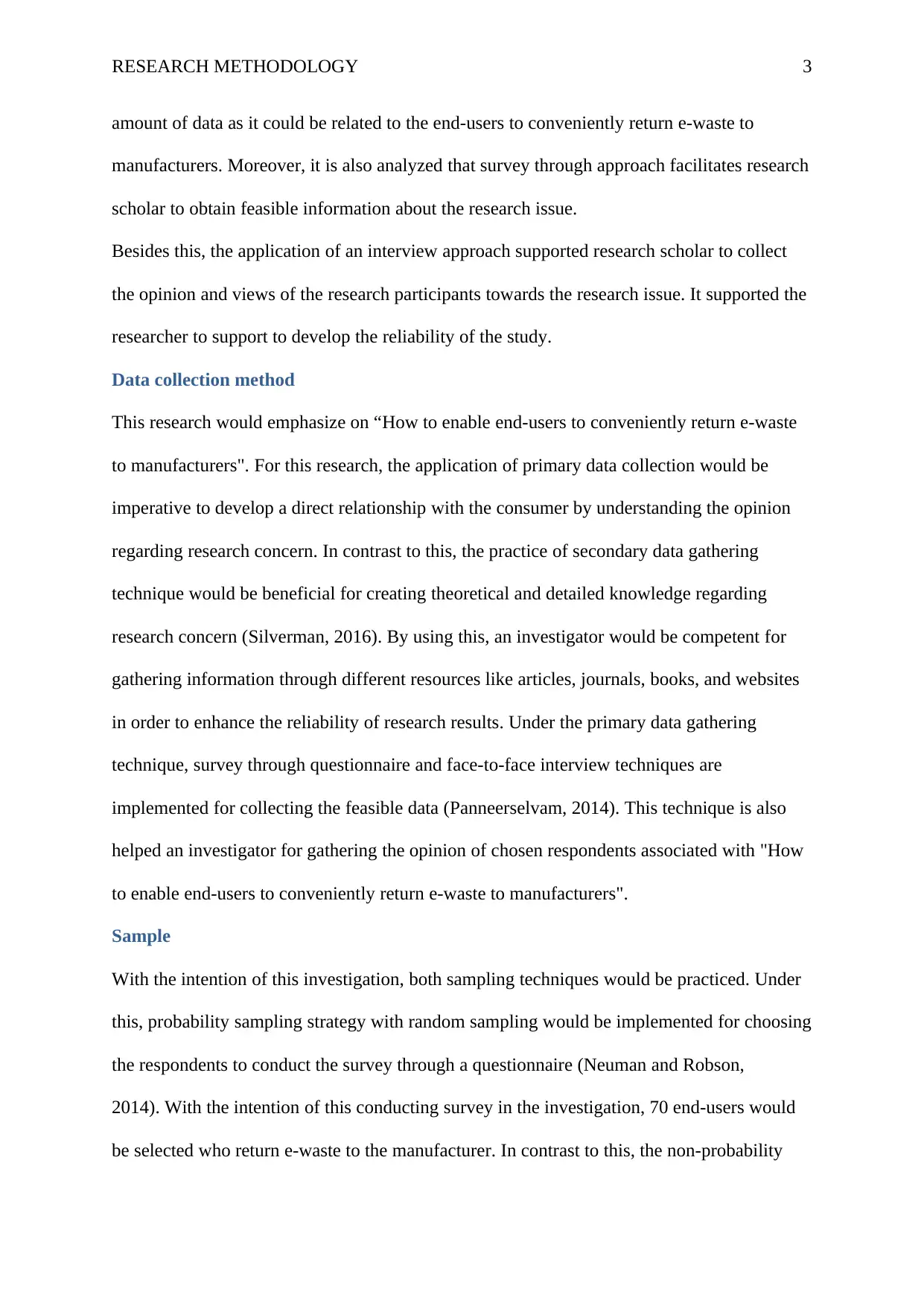
RESEARCH METHODOLOGY 3
amount of data as it could be related to the end-users to conveniently return e-waste to
manufacturers. Moreover, it is also analyzed that survey through approach facilitates research
scholar to obtain feasible information about the research issue.
Besides this, the application of an interview approach supported research scholar to collect
the opinion and views of the research participants towards the research issue. It supported the
researcher to support to develop the reliability of the study.
Data collection method
This research would emphasize on “How to enable end-users to conveniently return e-waste
to manufacturers". For this research, the application of primary data collection would be
imperative to develop a direct relationship with the consumer by understanding the opinion
regarding research concern. In contrast to this, the practice of secondary data gathering
technique would be beneficial for creating theoretical and detailed knowledge regarding
research concern (Silverman, 2016). By using this, an investigator would be competent for
gathering information through different resources like articles, journals, books, and websites
in order to enhance the reliability of research results. Under the primary data gathering
technique, survey through questionnaire and face-to-face interview techniques are
implemented for collecting the feasible data (Panneerselvam, 2014). This technique is also
helped an investigator for gathering the opinion of chosen respondents associated with "How
to enable end-users to conveniently return e-waste to manufacturers".
Sample
With the intention of this investigation, both sampling techniques would be practiced. Under
this, probability sampling strategy with random sampling would be implemented for choosing
the respondents to conduct the survey through a questionnaire (Neuman and Robson,
2014). With the intention of this conducting survey in the investigation, 70 end-users would
be selected who return e-waste to the manufacturer. In contrast to this, the non-probability
amount of data as it could be related to the end-users to conveniently return e-waste to
manufacturers. Moreover, it is also analyzed that survey through approach facilitates research
scholar to obtain feasible information about the research issue.
Besides this, the application of an interview approach supported research scholar to collect
the opinion and views of the research participants towards the research issue. It supported the
researcher to support to develop the reliability of the study.
Data collection method
This research would emphasize on “How to enable end-users to conveniently return e-waste
to manufacturers". For this research, the application of primary data collection would be
imperative to develop a direct relationship with the consumer by understanding the opinion
regarding research concern. In contrast to this, the practice of secondary data gathering
technique would be beneficial for creating theoretical and detailed knowledge regarding
research concern (Silverman, 2016). By using this, an investigator would be competent for
gathering information through different resources like articles, journals, books, and websites
in order to enhance the reliability of research results. Under the primary data gathering
technique, survey through questionnaire and face-to-face interview techniques are
implemented for collecting the feasible data (Panneerselvam, 2014). This technique is also
helped an investigator for gathering the opinion of chosen respondents associated with "How
to enable end-users to conveniently return e-waste to manufacturers".
Sample
With the intention of this investigation, both sampling techniques would be practiced. Under
this, probability sampling strategy with random sampling would be implemented for choosing
the respondents to conduct the survey through a questionnaire (Neuman and Robson,
2014). With the intention of this conducting survey in the investigation, 70 end-users would
be selected who return e-waste to the manufacturer. In contrast to this, the non-probability
⊘ This is a preview!⊘
Do you want full access?
Subscribe today to unlock all pages.

Trusted by 1+ million students worldwide
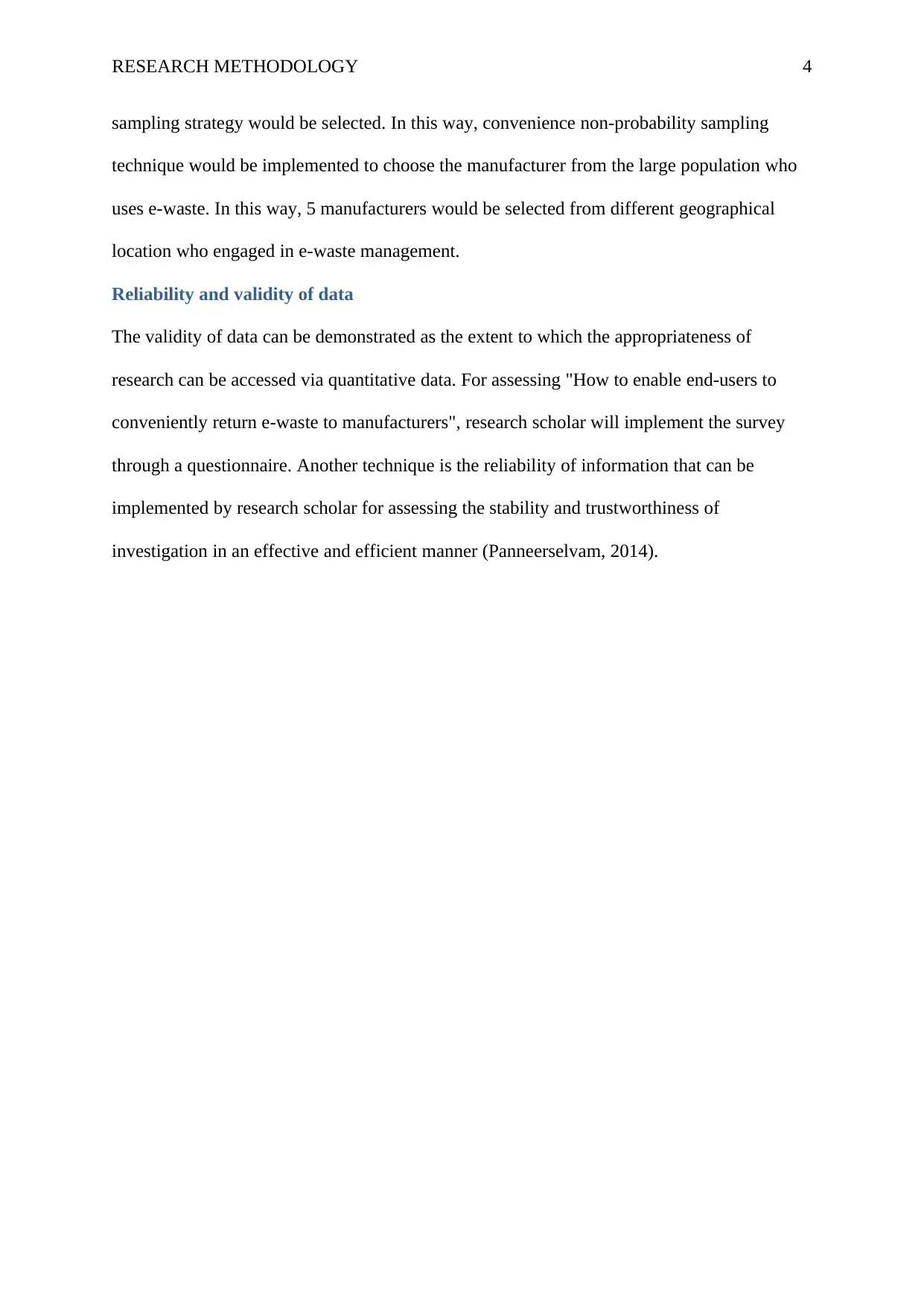
RESEARCH METHODOLOGY 4
sampling strategy would be selected. In this way, convenience non-probability sampling
technique would be implemented to choose the manufacturer from the large population who
uses e-waste. In this way, 5 manufacturers would be selected from different geographical
location who engaged in e-waste management.
Reliability and validity of data
The validity of data can be demonstrated as the extent to which the appropriateness of
research can be accessed via quantitative data. For assessing "How to enable end-users to
conveniently return e-waste to manufacturers", research scholar will implement the survey
through a questionnaire. Another technique is the reliability of information that can be
implemented by research scholar for assessing the stability and trustworthiness of
investigation in an effective and efficient manner (Panneerselvam, 2014).
sampling strategy would be selected. In this way, convenience non-probability sampling
technique would be implemented to choose the manufacturer from the large population who
uses e-waste. In this way, 5 manufacturers would be selected from different geographical
location who engaged in e-waste management.
Reliability and validity of data
The validity of data can be demonstrated as the extent to which the appropriateness of
research can be accessed via quantitative data. For assessing "How to enable end-users to
conveniently return e-waste to manufacturers", research scholar will implement the survey
through a questionnaire. Another technique is the reliability of information that can be
implemented by research scholar for assessing the stability and trustworthiness of
investigation in an effective and efficient manner (Panneerselvam, 2014).
Paraphrase This Document
Need a fresh take? Get an instant paraphrase of this document with our AI Paraphraser
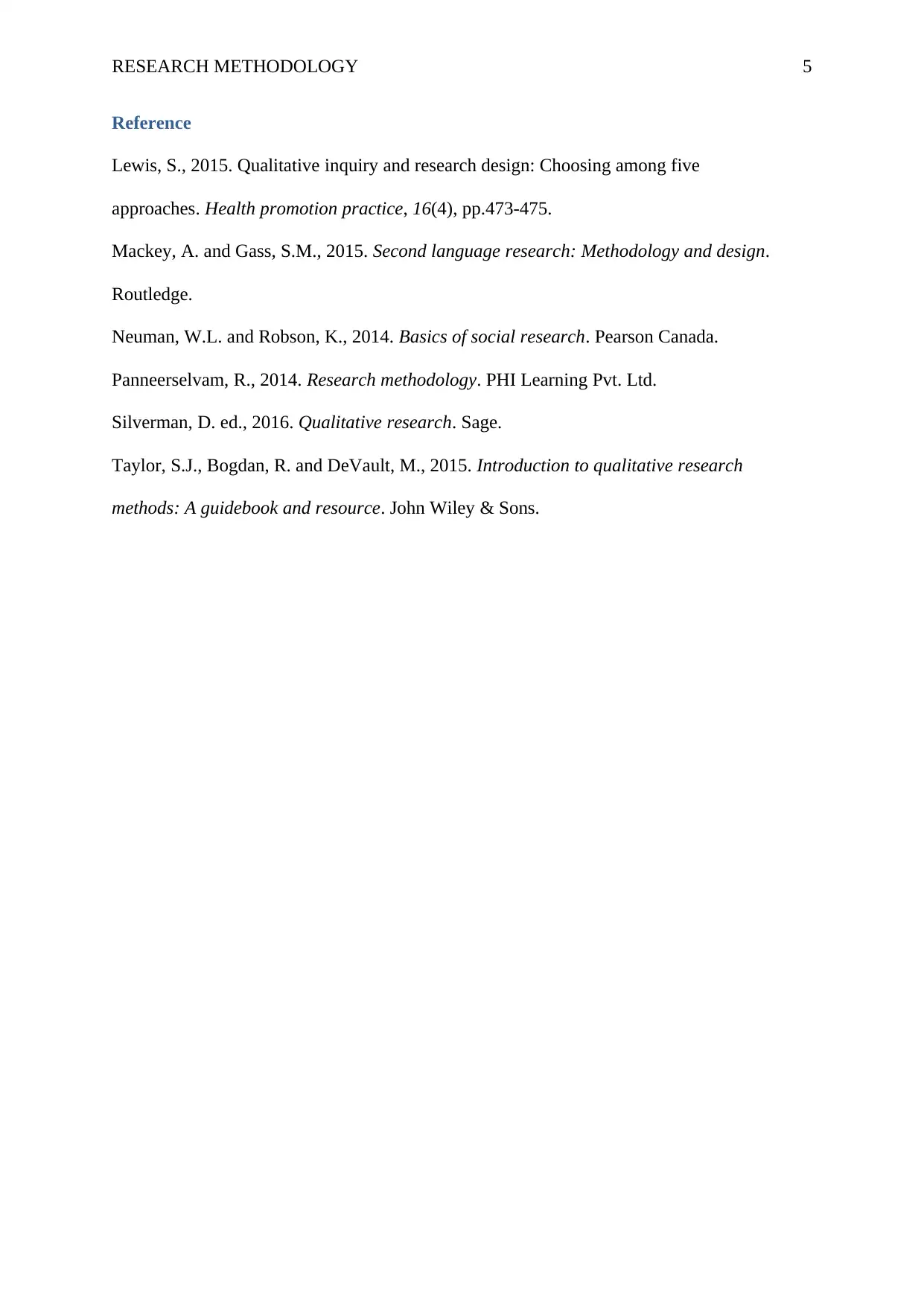
RESEARCH METHODOLOGY 5
Reference
Lewis, S., 2015. Qualitative inquiry and research design: Choosing among five
approaches. Health promotion practice, 16(4), pp.473-475.
Mackey, A. and Gass, S.M., 2015. Second language research: Methodology and design.
Routledge.
Neuman, W.L. and Robson, K., 2014. Basics of social research. Pearson Canada.
Panneerselvam, R., 2014. Research methodology. PHI Learning Pvt. Ltd.
Silverman, D. ed., 2016. Qualitative research. Sage.
Taylor, S.J., Bogdan, R. and DeVault, M., 2015. Introduction to qualitative research
methods: A guidebook and resource. John Wiley & Sons.
Reference
Lewis, S., 2015. Qualitative inquiry and research design: Choosing among five
approaches. Health promotion practice, 16(4), pp.473-475.
Mackey, A. and Gass, S.M., 2015. Second language research: Methodology and design.
Routledge.
Neuman, W.L. and Robson, K., 2014. Basics of social research. Pearson Canada.
Panneerselvam, R., 2014. Research methodology. PHI Learning Pvt. Ltd.
Silverman, D. ed., 2016. Qualitative research. Sage.
Taylor, S.J., Bogdan, R. and DeVault, M., 2015. Introduction to qualitative research
methods: A guidebook and resource. John Wiley & Sons.
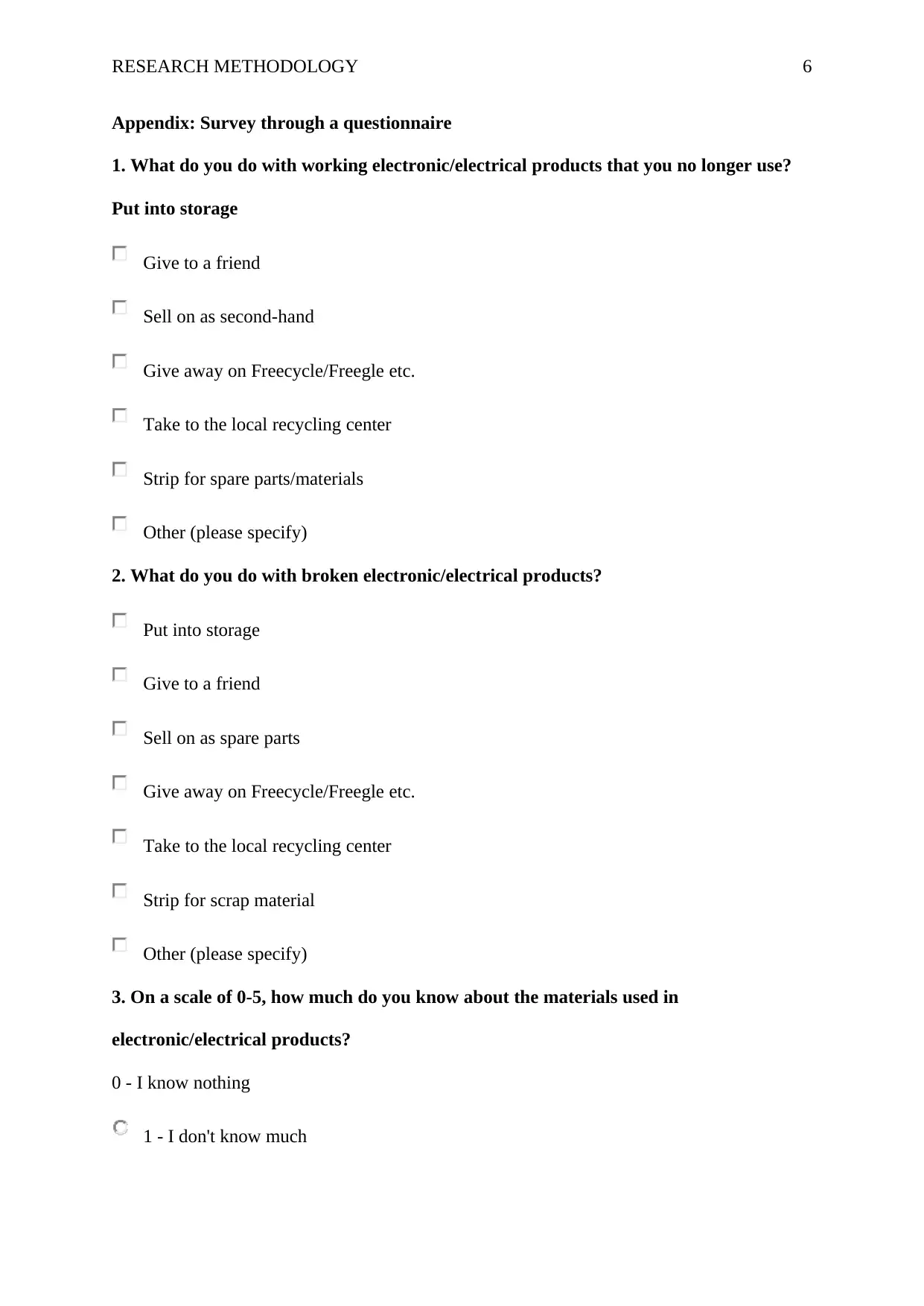
RESEARCH METHODOLOGY 6
Appendix: Survey through a questionnaire
1. What do you do with working electronic/electrical products that you no longer use?
Put into storage
Give to a friend
Sell on as second-hand
Give away on Freecycle/Freegle etc.
Take to the local recycling center
Strip for spare parts/materials
Other (please specify)
2. What do you do with broken electronic/electrical products?
Put into storage
Give to a friend
Sell on as spare parts
Give away on Freecycle/Freegle etc.
Take to the local recycling center
Strip for scrap material
Other (please specify)
3. On a scale of 0-5, how much do you know about the materials used in
electronic/electrical products?
0 - I know nothing
1 - I don't know much
Appendix: Survey through a questionnaire
1. What do you do with working electronic/electrical products that you no longer use?
Put into storage
Give to a friend
Sell on as second-hand
Give away on Freecycle/Freegle etc.
Take to the local recycling center
Strip for spare parts/materials
Other (please specify)
2. What do you do with broken electronic/electrical products?
Put into storage
Give to a friend
Sell on as spare parts
Give away on Freecycle/Freegle etc.
Take to the local recycling center
Strip for scrap material
Other (please specify)
3. On a scale of 0-5, how much do you know about the materials used in
electronic/electrical products?
0 - I know nothing
1 - I don't know much
⊘ This is a preview!⊘
Do you want full access?
Subscribe today to unlock all pages.

Trusted by 1+ million students worldwide
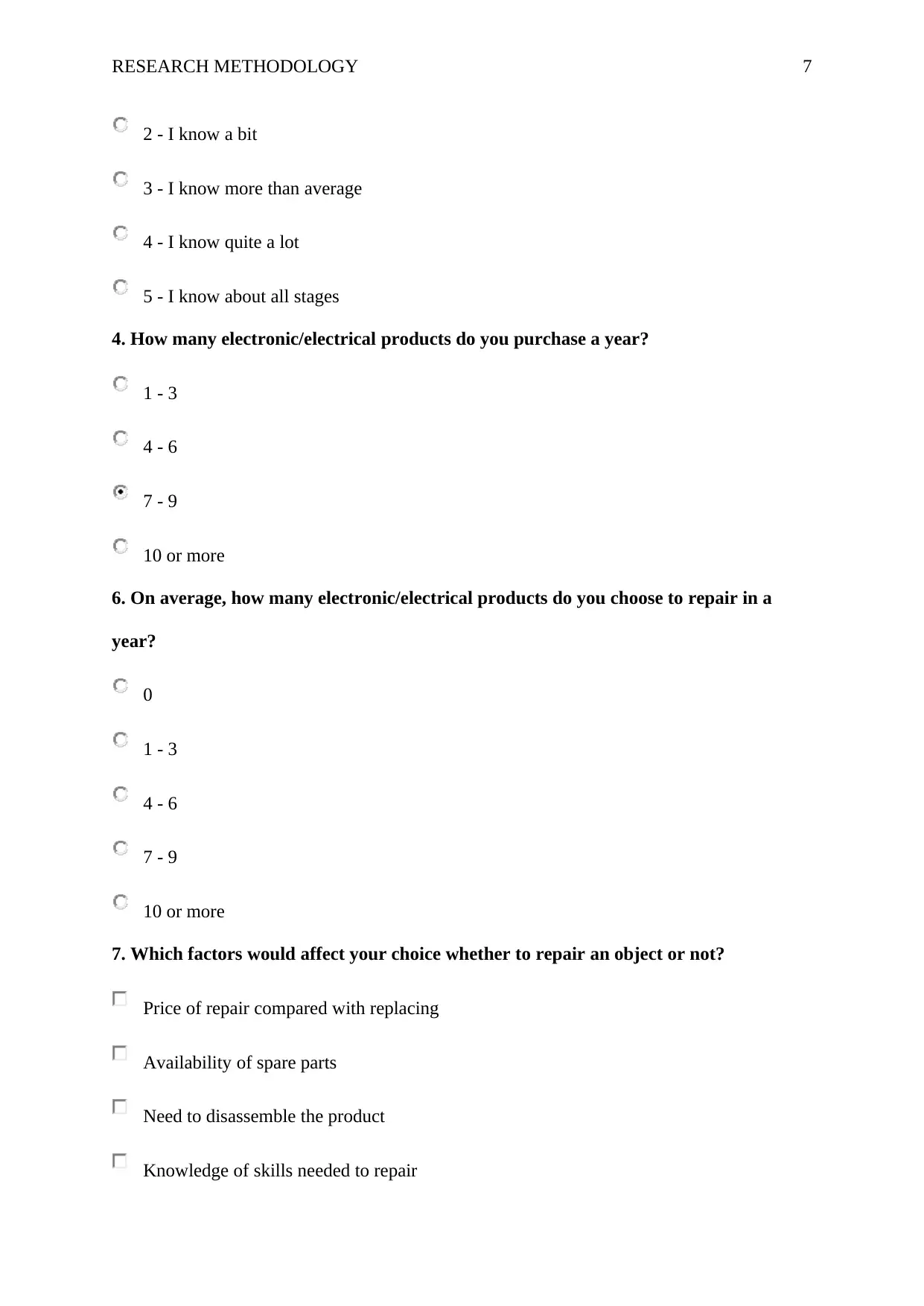
RESEARCH METHODOLOGY 7
2 - I know a bit
3 - I know more than average
4 - I know quite a lot
5 - I know about all stages
4. How many electronic/electrical products do you purchase a year?
1 - 3
4 - 6
7 - 9
10 or more
6. On average, how many electronic/electrical products do you choose to repair in a
year?
0
1 - 3
4 - 6
7 - 9
10 or more
7. Which factors would affect your choice whether to repair an object or not?
Price of repair compared with replacing
Availability of spare parts
Need to disassemble the product
Knowledge of skills needed to repair
2 - I know a bit
3 - I know more than average
4 - I know quite a lot
5 - I know about all stages
4. How many electronic/electrical products do you purchase a year?
1 - 3
4 - 6
7 - 9
10 or more
6. On average, how many electronic/electrical products do you choose to repair in a
year?
0
1 - 3
4 - 6
7 - 9
10 or more
7. Which factors would affect your choice whether to repair an object or not?
Price of repair compared with replacing
Availability of spare parts
Need to disassemble the product
Knowledge of skills needed to repair
Paraphrase This Document
Need a fresh take? Get an instant paraphrase of this document with our AI Paraphraser
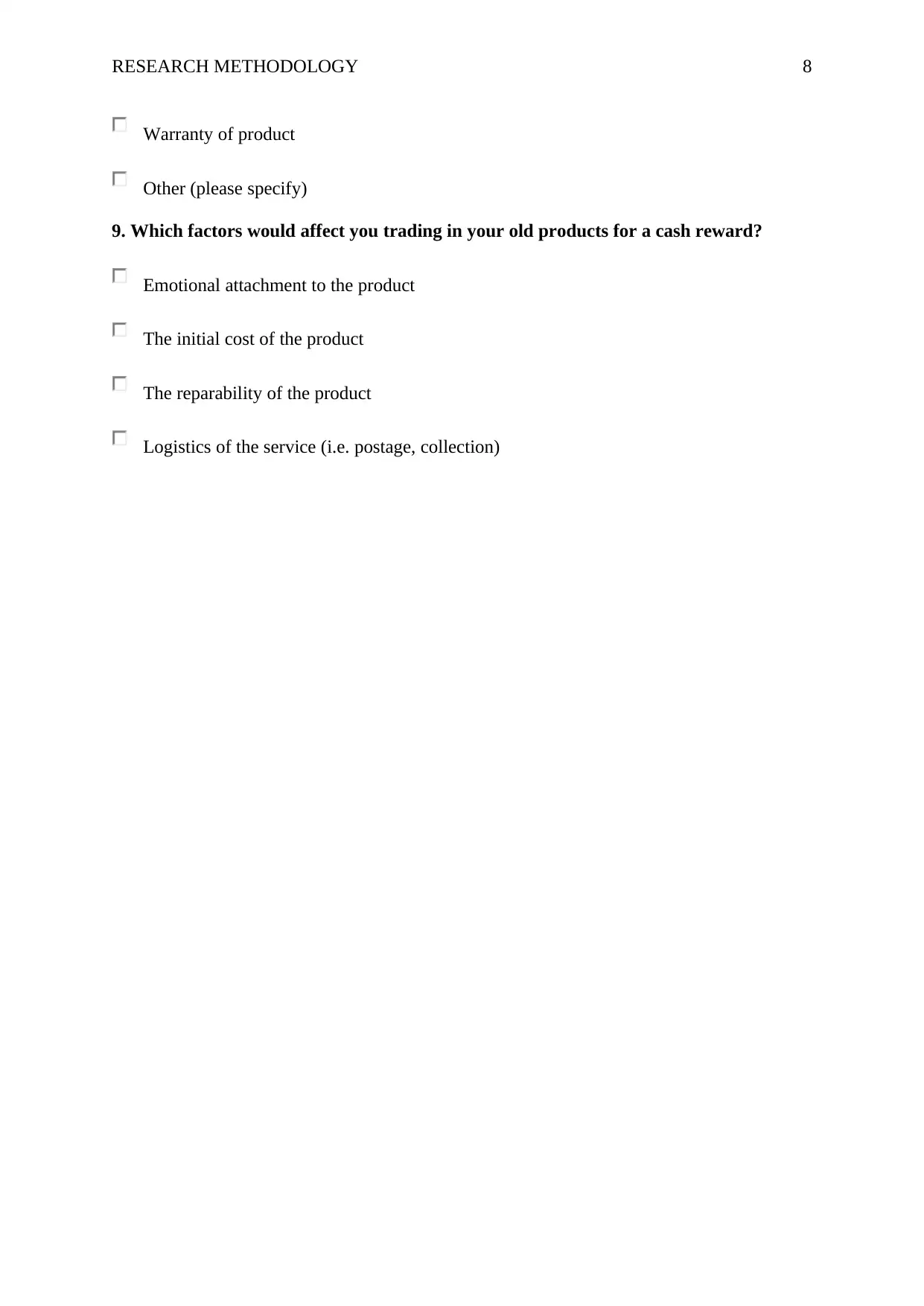
RESEARCH METHODOLOGY 8
Warranty of product
Other (please specify)
9. Which factors would affect you trading in your old products for a cash reward?
Emotional attachment to the product
The initial cost of the product
The reparability of the product
Logistics of the service (i.e. postage, collection)
Warranty of product
Other (please specify)
9. Which factors would affect you trading in your old products for a cash reward?
Emotional attachment to the product
The initial cost of the product
The reparability of the product
Logistics of the service (i.e. postage, collection)
1 out of 8
Related Documents
Your All-in-One AI-Powered Toolkit for Academic Success.
+13062052269
info@desklib.com
Available 24*7 on WhatsApp / Email
![[object Object]](/_next/static/media/star-bottom.7253800d.svg)
Unlock your academic potential
Copyright © 2020–2025 A2Z Services. All Rights Reserved. Developed and managed by ZUCOL.




